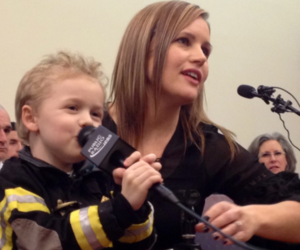NFL Player Clay Matthews Raises Money for Muscular Dystrophy with Special Cleats

Photo: NFL Player Clay Matthews. Source: Acme Packing Company.
Football is for some a way of life, but for many die-hard fans, playing the sport itself is just a dream. This is especially true for kids diagnosed with life-altering illnesses such as Duchenne muscular dystrophy (DMD).
While playing the sport may not be a possibility for these kids, the opportunity to be a part of something big and memorable like a pro football game or participating in other major events is.
Unique and different fundraising opportunities are cropping up daily. These initiatives are often inspired by diseases, the people who are dealing with them and the hope that a cure will be found in the not-so-far future.
Recently, the initiative My Cause My Cleats, which sees NFL players wear a special pair of cleats during a game, had Green Bay Packers’ player Clay Mathews sport cleats designed by two boys who suffer from DMD.
The game not only brought special attention to the sport of football and the player, but it also raised awareness about Duchenne muscular dystrophy, which is a rare neuromuscular disease that affects many children. The game also showcased the design talents of two young fighters who live with a debilitating disease every day. All this attention ultimately benefited those with DMD by helping to raise money for more research.
Simply put, fundraising is the act of asking for and gathering various contributions, money and even resources from donors. Typically an organization's main goal for launching fundraising initiatives is to maintain operations and to meet its set mandate. A mandate is essentially the promise the organization has made - for example, to provide financial support to families who are unable to fund the cost of infant hearing aids.
Other times, the fundraising is done to increase research for diseases, disorders or disabilities. Typically a portion of the funds raised will go towards the operation of the fundraising organization like the American Cancer Society, and a portion will go towards the research itself.
Some of the more traditional ways of raising a few dollars include:
- Auctions: From silent auctions to live bidding, auctions can successfully raise lots of money a charity.
- Dinners and galas: Who doesn’t like a fancy night out? It’s even better when that night out supports a cause.
- Marathons: This type of event pairs the competitive spirit with the giving nature - a perfect match.
- Bake sales and car washes: This is a great way for schools or church groups to raise money for a cause.
While these types (and many more) of events are typically successful at raising significant amounts of money, they sometimes fall shorts when it comes to raising awareness for the cause itself.
Raising awareness is when a campaign is launched with the purpose of changing people’s attitudes or behaviors towards a cause or disease. Sometimes these campaigns are launched with an actual end goal in mind by a specific organization. The infamous Ice Bucket Challenge for MS is a good example of this. Other times, it begins as a small movement by people who are not connected to an organization. Who can forget the flurry of social media status with “blue” “black” “beige with lace” back in 2010 that quickly took hold of the world and saw a significant jump in breast cancer supporters?
Both times, the campaigns went viral on social media and ultimately, both campaigns succeeded in not only raising awareness about the causes, but also in lots of money.
Do awareness campaigns really work?
There is some controversy behind awareness campaigns - particularly when the campaign pushes for recognition for only one day. The autism awareness day on April 2nd is a good example of a very successful campaign that gave those with autism a voice. When you consider a large number of those who are on the autism spectrum are non-verbal – this is a very powerful statement. The campaign itself was a success but the one the big questions asked was “well what happens on April 3rd?” Does all talk about autism and the support for it come to a halt?
The truth is that a successful awareness campaign - whether it’s for a day or month or more - is considered to be successful because of the fact that the cause its raising awareness, for now, has a clear identity.
What type of campaign is more successful or more effective?
Neither one can be considered successful or effective. Both fundraising and awareness campaigns are great ways to reach the goal that surrounds a disease or a disorder.
However, by far, the most successful campaigns are those that combine both a fundraising and awareness campaign, such as the one that was used to raise awareness for DMD - My Cause My Cleats. Visiting the website will provide football fans and even the ‘not so much’ fans with a number of different causes that are supported by players.
Some awareness and fundraising campaigns are so successful that they end-up with well-known and very recognizable branding, for example, all things pink for Breast Cancer Awareness.
How do the funds help research?
Researching a disease, its cause and hopefully a cure costs a lot of money. Many research projects are funded by government grants but at some point, that money runs out. Fundraising campaigns, particularly the successful ones help those research projects to continue after the grant money is exhausted.
When a fundraising campaign is paired with an awareness campaign, the hope is that people’s behaviors will change enough to either donate money for the first time to a cause or, donate more money to the cause time and time again. This is why awareness campaigns are also a good way to build a bank of reliable donors. A children’s hospital will often combine both awareness campaigns with their fundraising campaigns. A great example of this is the Hospital for Sick Kids in Toronto, Canada. They built a unique, powerful and sometimes very raw awareness campaign that is helping them to raise funds to build a new hospital and ultimately save the lives of thousands of kids.
What are other benefits?
Another benefit to fundraising and awareness campaigns is just how far the money goes. It’s often overlooked but many times, charities will ensure that the funds go beyond the operations and research initiatives. Many successful campaigns have also resulted in other programs such as early screening for disease or other movements such as the stop smoking campaigns. Both of these initiatives save millions of lives each year and most of them exist because of people’s generosity.
Anyone can raise funds and awareness for a cause that is dear to them. A key part of a successful campaign is that it should resonate with the people who are being asked to give. This is often done by pulling at the heart strings of many donors, just think about those images of starving children that usually appear around the Holidays. Some people may think that sort of thing is just a marketing ploy - and yes it may be but, what’s important to remember is that typically, after those first images are shown, they are followed by the images of those same children, happy, healthy and striving in school. That is because someone cared enough to start talking about the situation, raised awareness about it and asked for money to help.















